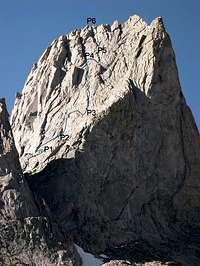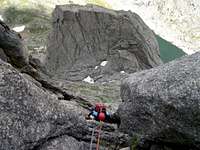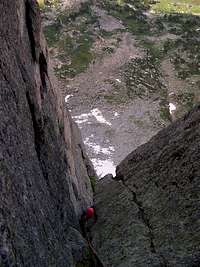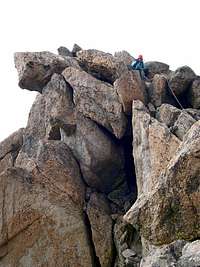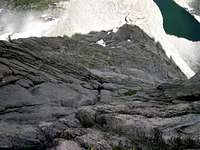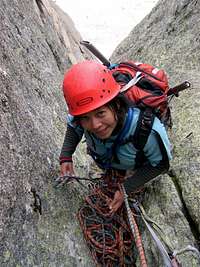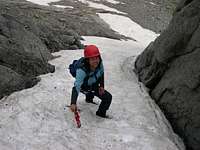|
|
Route |
|---|---|
|
|
42.76110°N / 109.2144°W |
|
|
Mountaineering |
|
|
Summer |
|
|
Most of a day |
|
|
5.7 (YDS) |
|
|
II-III 5.7 |
|
|
6 |
|
|
III |
|
|
Approach
Note that the new (2008) guidebook by Steve Bechtel (A Select Guide To The Wind Rivers' Best Rock Climbing, ISBN 978-1-933009-16-2) puts this route at III 5.8 and gives FA credit to Eric Beck & Steve Roper in 1962.
Follow the approach directions for Cirque Of The Towers (see main Warbonnet page). The technical rock climb section begins at the Warbonnet-Plume (the latter being a "small" pinnacle attached to the NE face of Warbonnet) notch on the northeast side of the mountain. Two ways of accessing the notch are:
(1) From The Cirque: Hike towards the obvious snow-filled gully directly beneath the notch (it will be snow filled year round most likely during most years) on the north side of Warbonnet. Climb the gully (c. 30-40 degree snow) towards the notch. In late season, snow cover will be intermittent and you will be forced to overcome steep (and wet) slabs. Near the top as the gully widens, it might be easier to step left onto class 4 rock for the final 100-200 feet. The gully was generally unpleasant when we climbed it in early August '04. Most will want an ice ax and depending on time of day a set of crampons. Note that this approach is longer than one would expect. Hence you probably don't want to leave stuff at the base (carry all your stuff over with you) - you're not coming back the same way.
(2) From Jackass Pass: Kelsey's guidebook also gives an option of reaching the notch from the south via "boulder filled chutes [that] connect grassy ledges". Goal in this approach is to reach a long, diagonal chute that sweeps in behind The Plume. Kelsey rates this approach at class 4. We have not done this approach. You would most likely start this approach from near the highpoint of Jackass Pass (on the climbers' trail thru. the pass and NOT the hikers' trail).
Route Topo & Overlays
Photo Topo 1
Photo Topo 2
Route Description
This is an adventure climb - at least it will be if (1) all the info. you have came from Kelsey's guidebook and (2) 5.7-5.8 is not a trivial walk-up grade for you. Don't necessarily let the grade II rating fool you into sleeping in late on the day of the climb.
In addition to having a poor-quality photo with this route (and two more) superimposed on it (most likely this does not reflect reality anyway), this is what Kelsey has to say about this route in his book (paraphrasing):
While not classic,...routes offer some nice climbing.....scramble left from Plume notch to a right facing dihedral and follow it for a few easy pitches. Above a short, left-facing corner continue up, then right, for a few 5.7 pitches to the rightmost chimney...head up the chimney....
If this is all you have with you at the notch, you will scratch your head and just head up. With some backtracking and traversing you'll eventually find yourself either on the summit (if lucky) or rapping back down to the notch (having left some gear in the process). We saw evidence of both such outcomes. As this photo shows, there's a load and a half of dihedrals visible from the notch. As it turned out (in our interpretation of the route), you follow none of them.
The route reaches the summit of Warbonnet in six fun, bit loose, somewhat runout pitches.
Pitch 1: 4th class - 5.0, 180 feet. From the notch, head straight up over low angle slabs to reach a huge, grassy ledge beneath the beginning of a steeper part of the face.
Pitch 2: 5.6, 180 feet or until rope drag stops you. Traverse (walk!) left about 30-40 feet and climb up a short dihedral (about 20-30 feet up?). Above the dihedral (which is probably about 5.6), move up and right along a sloping ramp. Belay when convenient or when out of rope.
Pitch 3: 5.7, 180 feet. Continue up the "ramp" until able to move up. There should be some sort of a "groove" going up ("there should be" means that I headed up too early and ended up traversing/downclimbing to reach this "groove"....my second had to pendulum across). Belay near the end of the rope - there should be a small stance next to a horn with rap slings around it.
Pitch 4: 5.7, 180 feet. This is the crux pitch and it felt stiff for 5.7. My perceived "stiffness" could have been due to the uncertain psychological state (had no idea if I was on route at this point), dirty and a bit loose rock, or questionable pro. Or maybe the moves really were hard for a .7? Climb more or less straight up possibly veering slightly to the left. You're climbing flakes and mossy cracks on a fairly steep wall here. About 2/3rds of the way up you should pass a piece of cord wedged behind something (first tip off that maybe you're on route). Further up, you should see a piton (don't be too happy - it flexes quite a bit in your fingers if you notice). Your goal for this pitch is to reach a small ledge at the mouth of a large (wet and mossy) chimney. There's also a 20-30 foot ramp/groove (~8 inches wide, with grass growing in it) going right and slightly up from here.
Pitch 5: 5.7, 100 feet. Instead of climbing up the chimney (might work for all I know...but Kelsey suggests a rightward traverse somewhere high on the route and that's what we did), move up the above-mentioned diagonal (rightward) crack. At the end of this crack downclimb about 15-20 feet and traverse just a touch further right along narrow ledges. Start moving up when terrain above becomes reasonable (should be pretty easy, about 5.6). In about 30 feet you'll arrive at the mouth of a much less prominent chimney. Belay where comfortable or rope drag stops you. I think there was another piton on this pitch (near top) as well as a fixed piece of gear (nut or hex with threads).
Pitch 6: 5.7, 200+ feet. Move up the chimney. The first awkward move might be 5.7, rest is 5.6 I think. The chimney is blocked about 20 feet up. Above another short chimney section follows. Further up, you can exit the chimney to the right and follow a very nice finger-to-hand crack to easy terrain above. Once on top, the first boulder you see is not the summit. The summit is the class 3 pile behind this boulder.
Such is our interpretation of this route. If you have a different one post it here.
Descent: You can most likely unrope at the summit. It's all class 3 from here (mostly class 2). From the summit, move south. Downclimb a class 3 chimney/gully for about 60 feet. You'll reach a fairly broad slope and a faint climbers' trail meandering among the boulders. Follow it down. You're heading down the backside of Warbonnet to the Warbonnet-Sundance Pinnacle Col. Few hundred feet (probably closer to 1000 feet) below the summit, the descent route enters a gully which then splits. The left (that's left as you're facing the descent down) gully looks improbable but is in fact class 3 and probably the quickest option down. Few more hundred feet below you reach the low point between Warbonnet and Sundance Pinnacle. Make a left here and follow talus down to the boulder field between North and Arrowhead Lakes (you should see the main trail below at some point). Head for the main trail. It's probably not the best idea to try and conserve your elevation and minimize travel distance by diagonalling left directly towards Jackass Pass. You'll be doing some boulder "hopping" among house-sized formations. The trail brings you back to Jackass Pass and The Cirque.
Essential Gear
Helmets!! Two ropes might be helpful if you have any doubts about completing this climb. Extra (cheap) gear in case you want to bail. Standard alpine rack with stress on cams in the 0.5-2inch range. Used some 3 and 3.5 inch pieces as well. All depends on your comfort level.



